Physiology Oct. 31st
1/13
There's no tags or description
Looks like no tags are added yet.
Name | Mastery | Learn | Test | Matching | Spaced |
|---|
No study sessions yet.
14 Terms
What are salt glands?
Non-mammalian marine vertebrates have specialized organs to eliminate excess salt. These glands are crucial for osmoregulation, actively secreting a highly concentrated salt solution to maintain internal fluid balance despite living in hypertonic environments.
Example: Herring gull
marine bird that drinks seawater and eats salty food (like fish)
Components:
Salt Gland: A lobe structure containing numerous secretory tubules that drain into a central canal.
Central Canal: Facilitates salt secretion, leading to an external pore.

What are the income and loss sources for terrestrial animals?
Terrestrial animals must manage their water and mineral budgets to avoid desiccation and maintain homeostasis, often facing significant challenges such as water scarcity and high evaporative loss.
Income Sources:
Eating (preformed water in food)
Drinking (free water)
Metabolic water (produced from biochemical processes like cellular respiration)
Loss Sources:
Evaporation (cutaneous and respiratory)
Urine
Feces
Salt glands (in some species, like marine reptiles that venture onto land)
Storage:
Bladders and lymphatic systems (for temporary water storage)
How do organisms obtain water?
Preformed Water: Water present in food, which can be a primary source for many animals, especially those in arid environments or with specific diets.
Mobile H2O: Free form, easily available and quickly absorbed (drinking water).
Bound H2O: Less accessible, often chemically or physically linked to food structures, requiring digestion to release.
Typical contributions:
Less than 10% from dry foods (e.g., seeds).
50-65% from fruits and vegetables.
60-80% from moist foods (e.g., fresh meat).
90% in high-water-content foods like cucumbers.
What is free water?
Definition: Water that can be ingested directly, readily available for drinking. Its availability heavily influences the distribution and behavior of many terrestrial species.
Larger animals tend to travel farther to find water and can survive longer without it due to a lower surface area-to-volume ratio, which reduces evaporative loss, and greater internal storage capacity.
Example: Frogs can absorb water through the highly vascularized pelvic patch skin, acting as a specialized drinking surface.
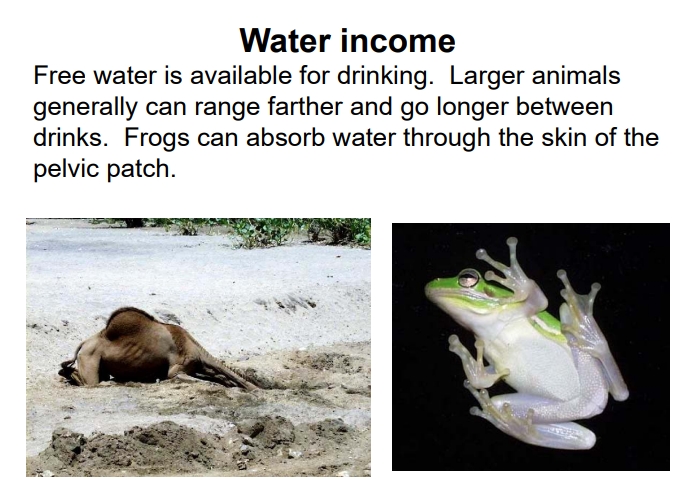
What is metabolic water?
Definition: Water produced by the oxidation of macronutrients (carbohydrates, lipids, proteins) during cellular respiration. This is a critical water source for animals in environments where free water is scarce.
Average Gross Amount of Water Produced in the oxidation of foodstuffs (Table 27.3):
Carbohydrate: 0.56 grams of H2O per gram of foodstuff
Lipid: 1.07 grams of H2O per gram of foodstuff (Lipids yield the most metabolic water due to their high hydrogen content).
Protein with Urea: 0.40 grams of H2O per gram of foodstuff
Protein with Uric Acid: 0.50 grams of H2O per gram of foodstuff
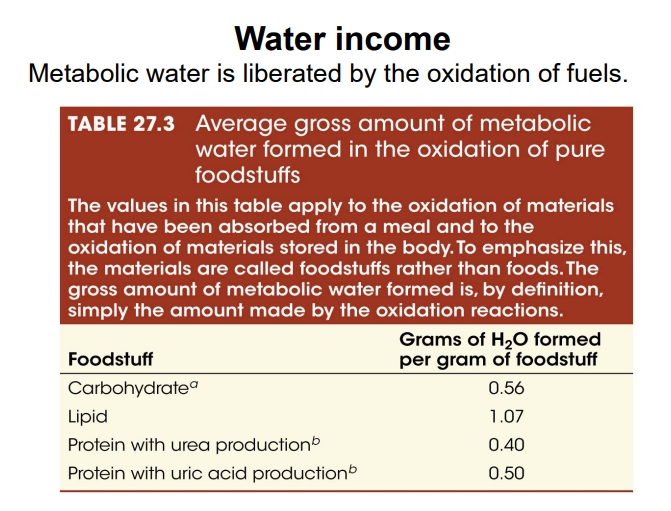
What is cutaneous evaporative water loss?
Definition: Water loss through the skin, primarily influenced by external layers that act as barriers to water diffusion.
Epidermis: Contains layers of lipids and waxes (e.g., cholesterol, phospholipids), which create a hydrophobic barrier.
Specialized Structures: E.g., epicuticle of arthropods (a waxy, waterproof outer layer) and stratum corneum of vertebrates, both serving to reduce desiccation.
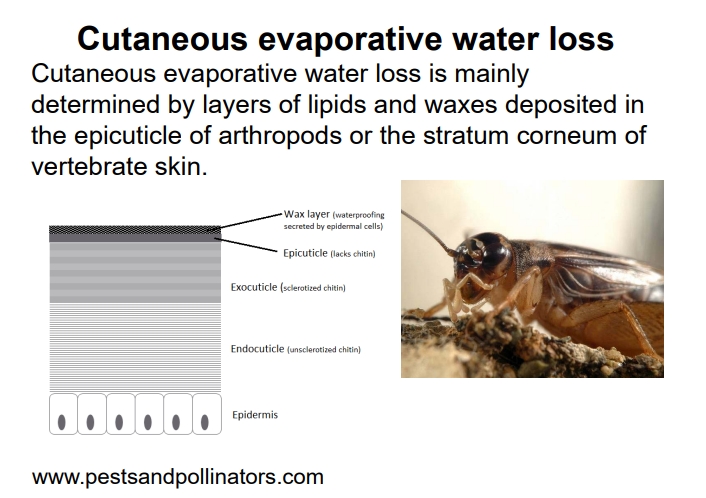
What is the stratum corneum?
The outermost layer of dead, flattened cells in vertebrate skin, rich in intercellular lipids (e.g., triglycerides, ceramides, free fatty acids, cholesterol).
This lipid-rich matrix forms a highly effective barrier to water diffusion, preventing uncontrolled water loss from the body.
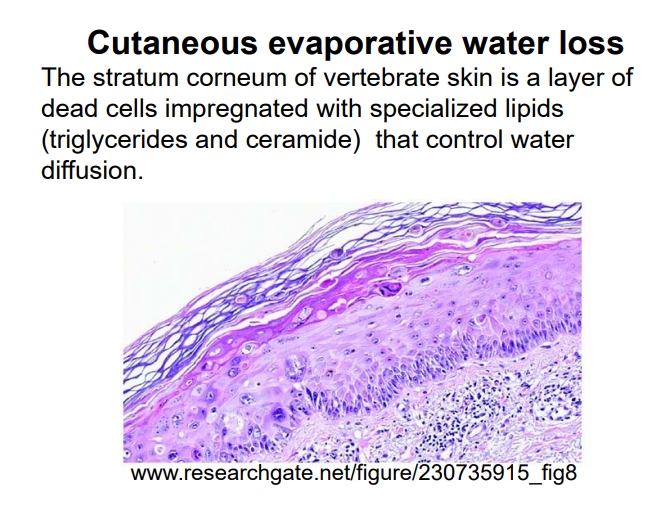
Explain water loss and humidity
Key Concept: The maximum amount of water vapor (H_2O) that air can hold increases exponentially with temperature. Warmer air can hold significantly more moisture.
Water capacity doubles for every 11^ ext{o}C increase in temperature.
Respiratory Water Loss: Depends on temperature and saturation differences between inhaled and exhaled air. Animals must humidify inhaled air to nearly 100% relative humidity before it reaches the lungs.
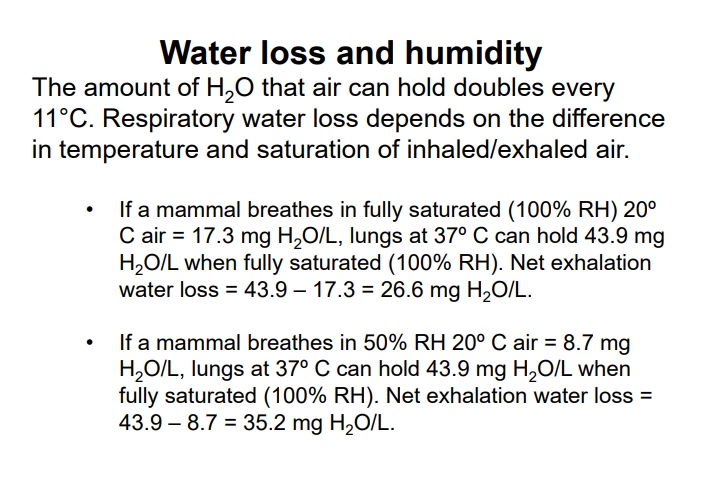
How can u calculate the net exhalation of water loss?
Calculations:
When a mammal breathes fully saturated air (100% Relative Humidity) at 20°C:
Inhaled air holds 17.3 mg H2O/L
At 37°C, the lungs can hold 43.9 mg H2O/L at saturation
Net Exhalation Water Loss:
43.9 mg H2O/L - 17.3 mg H2O/L = 26.6 mg H2O/L
Breathing in air with 50% relative humidity at 20°C (meaning it holds 17.3 mg H2O/L x 0.5 = 8.7 mg H2O/L)
Leads to:
43.9 mg H2O/L - 8.7 mg H2O/L = 35.2 mg H2O/L net exhalation loss. This demonstrates that drier inhaled air leads to greater respiratory water loss
What is respiratory evaporative water loss?
Loss of water through respiration can be minimized by recovering moisture in nasal passages, facilitated by turbinals (convoluted bones) that function as countercurrent heat and water exchangers.
As warm, moist air is exhaled, it passes over cooler nasal passages, condensing water vapor and reducing its temperature before it leaves the body.
Cooling down exhaled air, particularly prominent in small mammals, also reduces water loss during respiration, as cooler air holds less water vapor.
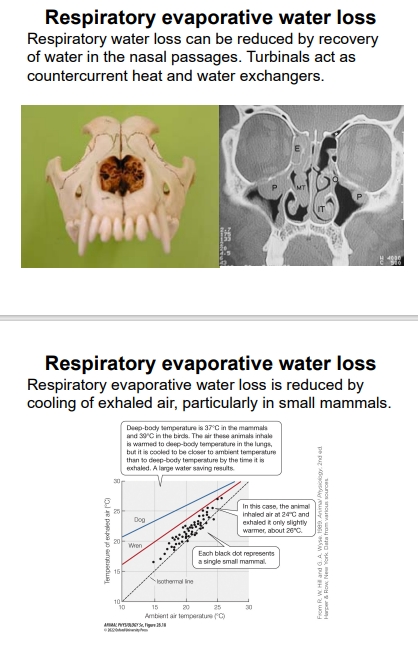
Explain the rate of evaporative water loss
The rate of specific evaporative water loss is connected to an organism's body weight, driven by relative surface area (smaller animals have larger surface area-to-volume ratios, thus higher relative loss) and metabolic rate.
Rates vary among different species and are notably lower in organisms adapted to dry environments (xeric adaptations), which have evolved specialized physiological and behavioral mechanisms to conserve water.
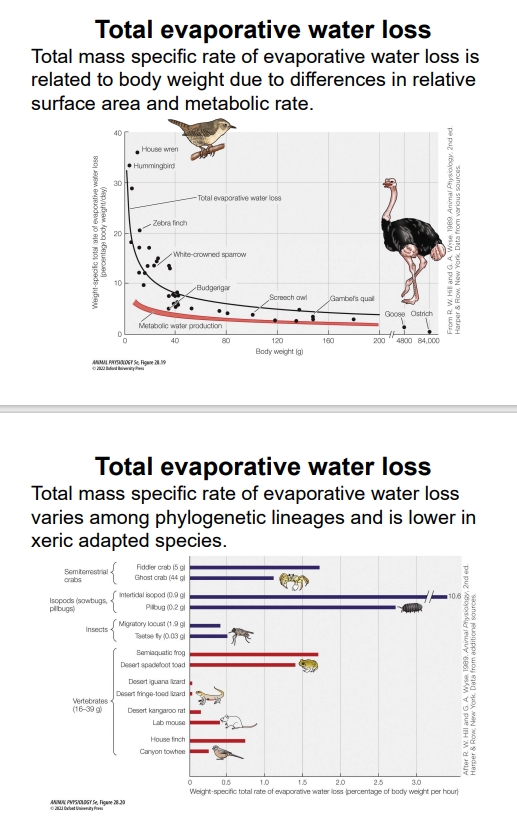
What is fecal water loss?
Fecal water loss tends to be higher in animals consuming lower digestible diets (e.g., herbivores generally losing more water than carnivores) because a larger volume of less digested material holds more water.
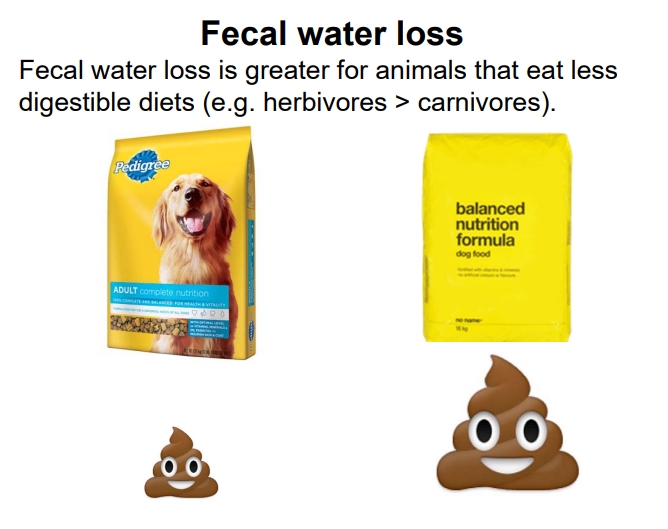
Explain urinary water loss
Influencing Factors:
U/P Ratio: The ratio of urea concentration in urine to its concentration in plasma. A higher U/P ratio indicates more concentrated urine and thus greater water conservation.
Salt Intake: Low salt intake can lead to lower urine concentrations as the body attempts to retain essential ions, while high salt intake necessitates more water for excretion.
Protein Intake: A diet high in protein increases the production of nitrogenous wastes, which often requires more water for excretion.
Type of Nitrogenous Waste: The form of nitrogenous waste significantly impacts the amount of water required for its excretion.
Profiles Indicating Water Loss (from most to least water required for excretion):
NH_4 (Ammonia) > Urea > Uric Acid
U/P
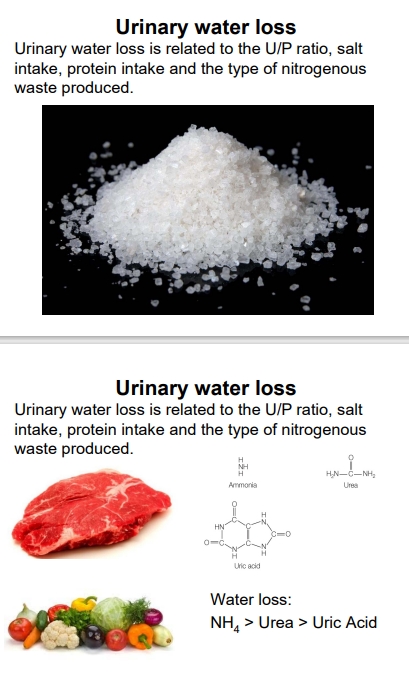
What are the different ways nitrogenous waste is excreted?
Ammonotelic Animals: Excrete ammonia directly, often in aquatic environments where it can be rapidly diluted due to its high toxicity. Requires substantial water for excretion.
e.g. bony fish, amphibian larvae (tadpoles), and many aquatic invertebrates.
Ureotelic Animals: Convert ammonia into urea for excretion, a less toxic and highly soluble form. Found in mammals, amphibians, and some marine fish. Requires less water than ammonia excretion.
e.g. Mammals (including humans), most adult amphibians, and some marine fish.
Uricotelic Animals: Excrete uric acid, which is even less toxic and precipitates out as a semi-solid or solid, conserving significant amounts of water. This adaptation is crucial for terrestrial animals like birds, insects, and most reptiles, where water conservation is paramount.
e.g. Birds, reptiles, insects, and land snails.